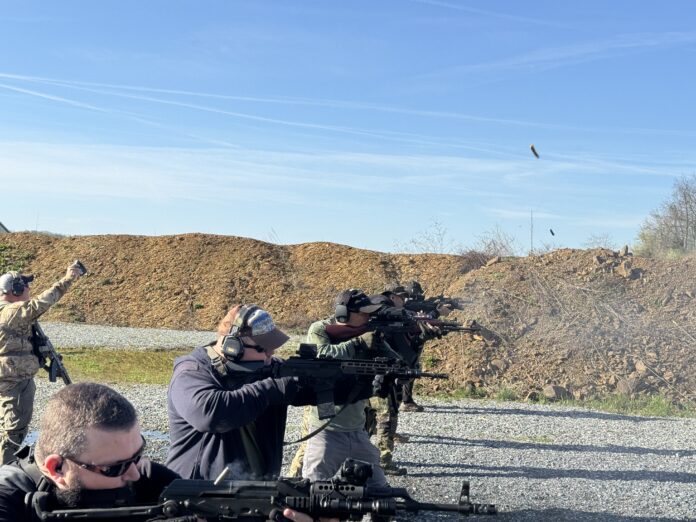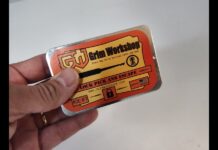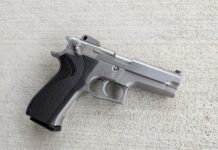
This isn’t some pithy pitch for you to sign up for some training subscription. There are plenty of good training locales, good instructors, and good ways to go about practicing the life-saving skills that firearm proficiency provide. Quick list of good places to Google: IWI Academy, Citizens Defense Research, Sentinel Concepts, Green Ops Training, Teufelshund Tactical (especially if you like MP5s), Symtac (especially for shotguns), Tactical Fitness Austin, and there are plenty more, but that should get you something to work with. But what I am asking specifically is if you are training correctly.
Are you, in your dry-fire and live-fire practice, picking the proper drills to hone fundamental skills? Or, as many are, are you over-shortcutting and leaving things behind?
This questions spawns from a conversation I had with a friend who was commenting about training “reloads” for speed. However, said friend was only training the mechanic of releasing the magazine and putting a new one in. Both magazines empty. No additional control manipulation.
This, ladies and gentlemen of the audience, is training wrong…
Now, there are specific instances where that mechanic may be of value, but most of them are in the competitive sense, not the tactical. They are certainly not the way to train the skill foundationally and then modify it for the tactic of the event.
My friend was not training for competition, they were training for ‘tactical’ in the sense of a reload during a fight.
So let me address some common errors I see in practice methods and then some ways to remedy them.
Stimulus/Response
The first error I see people make is false stimulus. I see it in reloads, malfunctions, and firearm transitions from long gun to handgun.
There needs to be a reason you are doing these things. If you are training to do them in an ’emergency’ setting, then the stimulus must be, or must be as close as feasible to, what the firearm will do in real life.
You don’t just ‘do’ an empty gun reload. The gun tells you it is empty, and then you reload it. You don’t just ‘tap-rack-bang’ a firearm after notionally saying “malfunction” in your head or aloud. The gun tells you something is wrong, and then you fix it. You don’t just decide to draw your sidearm to practice that when you have a primary.
There should be a conscious choice to do so, like limited space, and the pistol is the better gun for this particular moment. Or your primary gun is down. On that last one I am speaking of live fire exclusively. I’ll address dry later below.
Many drills, and some qualifications, that are allegedly to train or test these skills do so while omitting the stimulus. Without the stimulus, without the trigger for the response, we don’t know when to start doing the fix. We have only practiced part of the fix, and we are lacking the part that tells us there needs to be a fix in the first place. All of these skills are fixes for problems. We don’t do them when all is right in the world and with our primary gun.
I’ll list the drill type/skill type, and then I will cite the improper example and a proper example to fix the stimulus/response problem.
Speed/Emergency Reload
Scenario: Your gun is empty. That is bad. You need to make it not empty.
Speediest. Reload.
Wow. That certainly is fast.
Fast and picking a magazine up off a table, getting it into the gun, and then right back out of the gun. I would put good money on the failure of troops training this way, ejecting full magazines out of their guns right after putting them in. Why? That is the action they are practicing—immediate load and replace.
They aren’t practicing getting ammunition from where they actually wear ammunition, or in what they actually carry ammunition in. They aren’t practicing working the action on the QBZ-95. Whether it has a bolt release or a manual charge, they are doing neither.
In the most simple possible terms, this is a parlor trick.
You may also hear things referred to as ‘gaming’ the drill. That is giving yourself all the little cheats to do it fast (because that makes the brain happy with the good success chemicals) instead of practicing to do it correctly. Remember, these drills are specifically to fix problems. Shooting drills can be fast; these are problem-fixing drills, and they need to fix the problem.
Proper Speed Reload: 1-R-1
I’m going to use the most ammunition conserving version of the drill, the One-Reload-One. In reality two-reload-two or NSR-reload-NSR (Non-Standard Response, 2 to 5 rounds) are better technical indications of what you want to feel. But I know ammo is $0.50 a trigger pull as of this writing, and a 1-R-1 will get us what we need. I will also cover a way to do this dry-fire below.
Setup: Two magazines, one with rounds and one empty. Load a round into the chamber of your gun and then swap the magazine for the empty. You should have a loaded round and an empty magazine in the gun and then the magazine with ammunition in your preferred pouch, pocket, etc.
Running the drill:
- On signal, fire until the gun indicates empty. Use of a target that is moderately difficult to hit is recommended so that the shot process is still mandatory for success.
- Note: I didn’t say fire the shot and reload, fire until the gun indicates ’empty’. For most modern rifles and the majority of semi-auto handguns, this is indicated by bolt/slide lock. For firearms like the AK or a double-action revolver, the indication is a trigger press that drops the hammer with no shot.
- Perform the reload completely.
- Fire a final shot with a hit to the target, still preferably something that is a moderate challenge to hit so that the entire shot process is required.
Use a small target, like a 3-4″ circle at close distances. A reduced silhouette/c-zone steel at distance is also a good indicator. A target that requires a deliberate proper shot. This will mitigate the tendency to just get the gun back into “can fire” condition and ripping off the final round, because doing so will result in a miss.
When you can, turn this into a 2-R-2 or an NSR-R-NSR and require hits to advance. It will use more ammunition and slow down repetitions, but the speed of the repetitions matters less than the quality of the repetition.
Question: In the shoulder or out of shoulder for long gun reloads?
Answer: Out, almost always out of the shoulder. Controlling the gun’s movement by tucking the stock heel under the armpit allows much greater control of all the things you are doing with very little speed detriment. Especially if you yourself are moving between positions. It is not ‘the fastest’ reload if you are reloading from a static position, but it is the most consistent in all off-hand positions.
Dry-Fire: Time to Get Dummies/SnapCaps
Inert training ammunition or “dummies” are required here. Yes, required. Pony up the $20 or less and get a few. Yes, you can just over-muscle the slide/bolt release. No, you shouldn’t do that if $20 can make the stimulus far more correct. You want the gun to feel right, it is communicating with you tactilely. So get dummies, dummy. [/rant]
Yes, even for AKs and other non-locking guns, there is value in locking in magazines with round(s) resisting the insert and working the action to load one properly. This can help highlight and fix mistakes like riding the slide/charging handle and failing to fully chamber a round as a result.
Setup: Use two magazines, an empty magazine and one with the dummy round(s), or for revolvers, a speed loader, speed strips, or loose rounds as you carry/prefer. Set the magazine with dummy rounds like you would have it for a reload in a pouch, pocket, vest, etc.
- Insert the empty magazine into the firearm and work the action. This will either lock the action open or set up the firearm like it has fired the last round.
- Aim in and attempt to fire (obviously, it won’t).
- Perform the reload.
- “Fire” the reloaded firearm or at least acquire a good site picture.
These live and dry drill variants for the reload exercise the full range of motions involved in the reload. Now, if there is a certain part of the reload motion that needs to be practiced in isolation, such as the actual magazine exchange, isolating that and doing 5 or 10 good reps to clean up that isn’t a bad idea. However, that isolated skill clean-up must be integrated into the larger drill to hone and complete the reload cycle skill.
If you do not, then you can expect to be very good at the parlor trick portion, and that is it.
Transition to Pistol
Let me preface this one a bit. We are talking about the emergency transition to pistol here. The tactical transition to pistol, like a tactical reload, is not an emergency necessity. You don’t dawdle by any means, but it is the emergency transition to pistol due to a failure of the long gun that I see people practicing incorrectly.
How?
Their long gun isn’t down. It still works just fine. So, they are performing a tactical transition and calling it an emergency one. That doesn’t work.
Like the emergency reload, the emergency transition to the sidearm needs to be triggered by a stimulus—the long gun not working.
Luckily, like the emergency reload, there are easy ways to setup a proper stimulus.
Live Fire: 1-T-1
Like the one-reload-one above, this is for ammo efficiency. To get away from ‘gaming’ this drill a little more you can do non-standard responses before and after. But again, the single shot to failure and then solving the problem is the goal. We can reach the goal with a shot prior and after the fix.
Setup: Three magazines—two rifle, and one pistol. One rifle magazine with rounds and one empty. Load and holster your pistol. Load the rifle and then insert the empty magazine. Store the loaded rifle magazine in your reload pouch, pocket, etc. You can also do this for pump or semi-auto shotguns, just load one shell.
- Fire your long gun until failure.
- Again, do NOT just fire the shot and go to the transition because you know that it is coming. Induce the failure so you get the stimulus, and the gun tells you there is a problem.
- Transition to pistol.
- This requires two simultaneous actions—properly dropping the long gun to a stowed/slung position out of the way and drawing the pistol from the holster.
- Fire and get a 2nd hit on the target.
- Oh, you thought you were done? Ha! No. Time to get that long gun back working.
- Using the support hand, pick up and check the long gun.
- Yes, you know the gun is empty, but you can do variants on this drill with hard stoppages, too. Check the problem before solving the problem, so you solve the correct problem.
- Holster the pistol.
- Fix the problem and get the long gun loaded again.
Reset the drill with the empty magazine and repeat three to five times smoothly. You don’t have to beat any of these drills to death. If you notice a portion of the drill you are struggling with, isolate it and work that for a few good reps before integrating it back into the whole drill.
Dry Fire: Time for dummy rounds again
Setup: Three magazines—two rifle, and one pistol. A few snap caps/dummy rounds in one of the rifle magazines. Alternatively you can also use shotgun dummy shells and an empty shotgun. Seriously, get dummy rounds. It improves these drills. Setup the long gun empty, either action locked open properly at bolt lock on an empty magazine or action closed as is proper for the long gun.
- Attempt to fire.
- On long gun failure transition to sidearm.
- Examine long gun for failure type.
- Holster the pistol.
- Fix the long gun to a loaded status with a dummy round in the chamber.
Reset and run it through clean a few times. Again, no need to beat these to death if the stimulus and response are being done properly.
MALFUNCTION!
Stoppage… Jam… whole field of whoopsie daisies… whatever technical term you prefer, the gun stopped working. We will cover the soft and hard malfunctions/stoppages here in general. I don’t get into type I, II, III, IV, or thumb war. Too technical. There are two major categories and two ways to address them that solve nearly everything nearly all of the time.
The point is to get you into motion fixing the gun, not successfully identifying the stoppage exactly like some sort of stoppage anthropologist. You can also join these drills with the transition to pistol drill and should do that if you are carrying both guns.
Soft Stoppage: T-T-R-A
There are two reasons for a soft stoppage/malfunction.
- The chamber is empty.
- The round in the chamber is a dud.
Both of these problems are solved in the same way—get a good round into the chamber. To do this, follow T-T-R-A, Tap-Tug-Rack-Assess
- Tap: Make sure the magazine (if applicable, looking out for you, shotgun peeps) is properly seated into the firearm.
- Tug: Pull on the magazine to make certain it is seated properly and locked into place.
- Rack: Work the action all the way and at speed to eject the bad round (if there is one) and load a replacement round.
- Assess: Determine whether a shot is still necessary and act accordingly.
This is a more technically nuanced update to the old ‘tap-rack-bang,’ that conveys all the proper steps in a concise manner. It might not roll off the tongue as entertainingly, but still. The most common error I see people make while training this is skipping the Tap and Tug portion because they “know” they are ‘gaming’ the drill, that the magazine is seated, and that running the action will work.
Don’t. Game. Problem-solving drills. I see people who jump into a cycle of repeating the action that didn’t work over and over again because they thought the action would. They were gaming the steps instead of solving the problem and reading the stimulus.
Setup: One magazine of rounds or dummies. Start with the gun empty and at least one round or dummy in the magazine.
- Attempt to fire the gun until failure
- Gun will “click” in failure
- Tap (if applicable, tube magazines)
- Tug (if applicable, tube magazines)
- Rack (if applicable, revolvers)
- and Assess for shot necessity
- Fire if necessary
‘Surprise’ T-T-R-A , 5 – Shot Stoppage
This variant uses one or more live shots to simulate a more organic stoppage/malfunction.
Setup: One magazine with rounds and at least one dummy round. Place the dummy round so that it is somewhere between the 2nd to 5th shot in the gun. A live round should be in the chamber.
- Fire the gun until failure, achieving five good hits on a target of moderate difficulty.
- Yes, shot placement and process still, and always, matter.
- Tap, tug, rack, assess when the gun fails to fire.
- Complete the remainder of the 5 hits.
You can adjust the round count a little, but varying the amount before and after breaks up the pattern a little and can induce a better reaction to the failure stimulus instead of the count.
Aside: The problem with most low round count drills/qualifications is our pattern recognition learning loves to grab onto a number when that is consistent too. If I know the third drill in my qualification is always soft stoppage, and that it is always the 2nd round because that is how it is setup, I can gain a false sense of speed and efficacy because I am working with extra patterns that allow me to ‘game’ it.
Gaming a drill isn’t “wrong,” and the ability to game a drill doesn’t make the drill a bad one. But purposely gaming it defeats the purpose of problem-solving drills. Let speed drills be the speed drills. These are not speed drills, they aren’t to be done slow but they are not speed drills. /Aside.
Hard Stoppage: Out of Battery, All Variants
The problem I see with hard stoppage practice isn’t people doing it wrong. It is people not doing it at all.
There are many types of hard stoppages. I have found over the years that describing them all in detail and the technically most efficient method to fix each one tends to glass over eyeballs and make steam start pouring out of ears. It is too technical. There is too much going on, and identifying the technical aspect and remembering the nine to nineteen steps to fix it get in the way of actually fixing it.
Information overload of the technical sense overrides the dominant ability to act. I didn’t see any real way around it though, this is something to know in order to fix a major problem with your gun.
Then good old Clint Smith said some smart shit that I repeat to every class and person I have taught since I heard it.
“If the gun ain’t working. Unload the gun and then reload the gun, simple.”
Here is a list of hard stoppages
- Double Feed
- Stovepipe
- Failure to eject
- Failure to feed
- Failure to extract
- Failure to go into battery
- Bolt override (super fun in AR-15’s)
Those are seven distinct problematic stoppages, and each has nuanced ways to fix them. Some are specific to the gun you are shooting. However, all of them, on all platforms, come down to the two overriding actions that Clint so eloquently put.
- Unload the gun
- Reload the gun
Simple, get the problem all the way out of the gun and then put ammunition back in. Those are your ruling principles for solving the hard stoppage.
Setup: For most guns a double feed or a stovepipe are the easiest ones to induce this failure. Your choice. Crack the action of the firearm open and induce the out-of-battery condition of your preference. You can place a round in the chamber and then close the action gently to induce a double feed or you can open the action enough to stick a case partially into the open action to keep it open, either works. I personally like to practice on double feed as they are the more common.
- Attempt to fire until failure.
- Mushy/unresponsive trigger.
- Look at the action and observe how problematic it is.
- You could just be slightly out of battery and able to close the action on a semi-auto pistol for example.
- You could be able to smartly rack the action of a rifle that is mostly closed and clear the problem.
- Be smart, look and think, then solve.
- Pulling pressure off the magazine by holding back or locking the action open will help you. How, will depend on the gun you are practicing with.
- Remove the magazine (if applicable).
- Remove obstructing ammunition and cases.
- Let the action close.
- It should close completely, this is a good indication that the problem is probably solved.
- Check that the magazine has rounds ready to feed or grab a new magazine.
- Reinsert the magazine.
- Push and Pull the magazine to make sure it’s seated.
- Run the action to chamber the round.
- This will also give one last extraction and ejection opportunity to a round/case that may have been in the chamber, good or bad doesn’t matter. It goes and the new round takes the spot.
- Assess and fire if necessary.
Hard stoppages are complex, hence “hard” being the adjective. This simplified drill is still 10 steps. You can set it up with dummy rounds at home to work through it or you can practice it live on the range. I recommend doing both.
So, are you training these correctly?
The question that prompted the article. Are you doing these problem solving training items correctly? If not, try the ways I describe.
Is gaming ever ok?
Yes.
Gaming certain drills, especially reloads and transitions, is absolutely okay within the context of a game. USPSA, 2-Gun, and 3-Gun being excellent examples. The tactics of the game are different than the tactics of running the gun as a fighting implement, modifications of behavior to fit the game are therefore allowable.
I would recommend, however, that you train the base methods above first. Then modify them to the particular game you training for.



